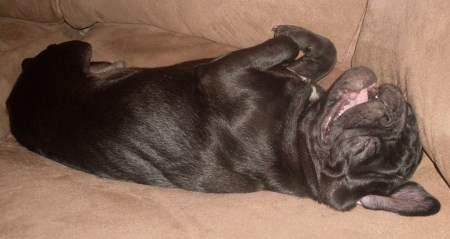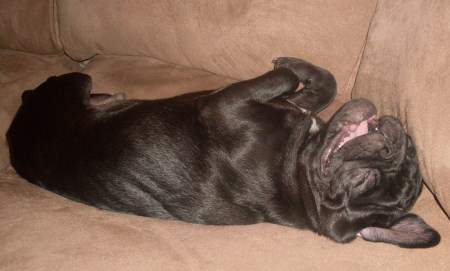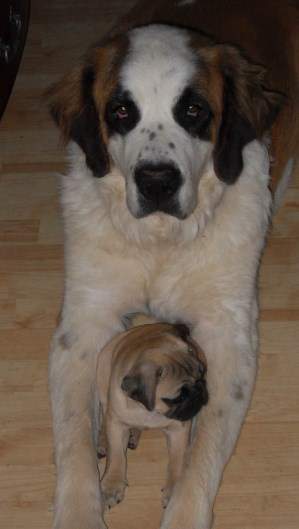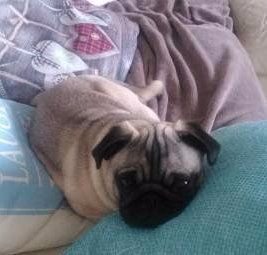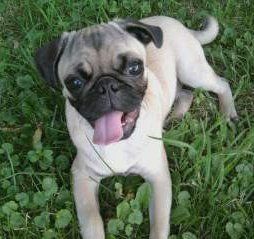Pug Dog Behavior
Overview
Every dog is an individual and will have his or her own quirks and character traits. With that said, each breed does have certain personality traits that while not found in every dog, are general behaviors that one can expect.
And when it comes to lovable behaviors and even temperament, the Pug places high on the list.
This section will discuss what you can expect with the Pug dog and tips for owners to deal with some of the more, well, let's just say, "interesting" aspects of this breed.
First, Let's Look at Some of the Rather Negative Traits that This Breed is Said to Have:
Stubbornness
Many sources will state that the Pug breed is stubborn and that does have a negative overtone to it. Most owners
will agree that the Pug knows what he wants...And he'll use a few different techniques to see if his owner will cave in.
For the right owner, this is not necessarily a bad thing... In many cases, what the dog wants is attention. Can who can blame him! This is not an independent breed.
Throughout generations, the Pug was bred to be a very valued companion and for quite a while this breed was kept by royalty. Pugs were even dressed up in clothing (mostly ruffled shirts and pantaloons) to sit at the front of horse-drawn carriages.
He was put on display and revered. Statues were built and artists spent time paining portraits of this unique breed.
Being a brachycephalic breed, the Pug was never extensively used for hunting and was only briefly used as a guard dog. Throughout history and up until today, Pugs have been and are indoor companion dogs. They crave the company of their humans.
What will a Pug do? It's not uncommon for his to plant his feet down and refuse to go outside with you... He may try and make you work for it a bit. If you are both resting on the sofa, he's sprawled half across your body and you want to get up to get a drink, your Pug may groan a bit and make you roll him off.
Most of his behaviors will be amusing, if you have a good sense of humor and if you are the type of owner who wants a dog with tons of personality.
Hard to Train?
Pugs are no harder to train than any other dog and most do excellent with both housebreaking and commands. It is important to note that any type of training is not accomplished in a day or even in a week.
The 2 elements that will help you train your Pug will be ones that compliment and play off of his personality. You'll need to work a bit to keep him focused and you'll need to follow proper guidelines in regard to praise and reward. In some aspects, a Pug dog does better than some other breeds simply because his desire to please his human and his love of tasty treats makes for a motivated dog.
There may be some quirks that make certain elements in need of extra attention. The Pug's easy going temperament and somewhat clingy personality can cause the dog to suffer with Separation Anxiety having a difficult time staying calm when left home alone.
Taking time to prepare a really good indoor environment can help quite a bit. Adding isolation to the problem of feeling panicked when left alone only compounds matters. For this reason most Pugs do well with a good sized indoor gated off area that is set up in a main room of the house.
The living room or kitchen are good choices. There should be space for toys and chews, a water dispenser, a food bowl, a comfortable sleeping area and a spot with newspaper or pee pads for bathroom needs. You can read more about this in the House Training section
Begging
Pugs do tend to have begging behaviors. If an owner gives in to this during the first year of puppy-hood, it can set up a foundation of begging behavior down the road. It is really difficult to not give in to those "puppy dog eyes" however, setting up rules and guidelines, with
feeding in particular, lends to better
health.
While some "human" foods are perfectly fine for a canine to consume, it is the manner in which a dog is given that food that will either reinforce or discourage the begging. While home cooking for this breed is highly recommended, any food given off of an owner's plate is not a good idea.
Once a dog is given any morsel, he will repeat the
begging behavior again. A dog metaphorically thinks, "If I begged and received, surely all I need to do is keep up this behavior and I'm sure to eventually receive a treat again!"
We all want our dogs to be our best friends yet at the same time, owners must establish themselves as the leader. Once this is learned, a Pug will obey commands, listen to the word "No" and show better manners.
Meals should be scheduled, and a Pug should be commanded to sit before his bowl is placed down.
Treats and snacks should be reserved for training (and once a Pug is fully trained, snacks can be reserved for reinforcing good behavior).
Note:
If a Pug always seems hungry
without good reason, reassess the quality of meals and snacks. Worms and other health issues can cause increased appetite, so bring this to the attention of the vet if you cannot resolve this.
Chewing
Chewing is usually a behavior that is triggered by something as opposed to being an inbred trait or part of a dog's personality. Teething certainly brings strong urges to chew and boredom (or anxiety) also causes a dog to chew.
For teething, offering ice cubes (either plain or flavored) can help to sooth sore gums. Chilling teething toys in the freezer can also help. Be sure to choose sturdy ones with different textures that promote good dental hygiene and healthy teeth. During this brief phase that all puppies go through, keeping personal items out of reach can prevent the destruction of shoes, pocketbooks, wallets, etc.
Keeping a close eye on a teething puppy allows an owner to quickly stop undesirable behavior: Clap your hands to get the pup's attention, take away any object that is not a toy and offer a good chew toy instead, offering praise as the puppy mouths it.
Temperament with Other Dogs
The Pug generally gets along well with other dogs. Some can be skittish of larger dogs and some will engage full force to be the life of the party.
It is rare for a Pug dog to be overly dominant to any other animal and his friendly nature may make him vulnerable to large, more aggressive canines. When out at dog parks or if visiting friends who have pets, it is always a good idea to keep watch.
Puppies, in particular, are very inquisitive, sometimes charging ahead into a situation in which they are not prepared.
The Pug is by no means shy or submissive to all other dogs, it is more a matter of this breed being a bit more curious and friendly as opposed to what may be other somewhat serious dogs.
With Children
This breed usually gets along very well with kids of all ages. In a household with younger children who may tend to get rowdy and noisy, it can be helpful to have an area set up in advance, that a Pug dog can retreat to if he is feeling overwhelmed.
Often, this can just be a dog bed or other resting area, set back a bit in a quiet corner of a main room. Even though the puppy or dog may want to take a break, he will still want to be able to see and hear his humans, therefore placing him in a separate room is usually not a good idea.
Tank (St. Bernard) and Pugsly (20 weeks old)
Photo courtesy of the Caywood Family
Mimicking
One of the best personalty traits of the Pug dog breed is his tendency to mimic his owners. Always aiming to please, a Pug will tend to be more laid back or more outgoing, depending on his owner's nature and habits.
This is a learned behavior and it can change over time. This breed is very adaptable, as long as his basic needs are met and he is in a healthy environment.
Energy Levels
Puppies will be more independent, exploring to find out the answer to "what is this?" although usually keeping his owner within eye sight. It is normal for Pug puppies to scamper around, sliding on floors and sniffing at just about everything.
It is also normal for pups to mouth objects, since that is one of their main methods of exploration and learning. For this reason, homes should be periodically "puppy proofed", removing any and all small objects off the floor and placed out of reach.
An adult will be more relaxed, often content to sit beside (or on) his owner in front of the TV. Because of the nature to copy behaviors, owners must be careful to not allow their Pug to become overtaxed while exercising which can cause breathing problems and/or overheating.
One or two 15 to 20 minute walks per day will help to keep this dog healthy....any longer activity periods than this should allow for water and rest breaks, preferably a shaded area. They tend to pick up cues from their humans and then follow along, so an owner should take the initiative to take breaks and never push the dog to go beyond what he can handle
Sensitivity
This breed is sensitive to his environment and to those around him. In regard to environment, not only does he physically react to temperature (he may shiver in a cold house and have trouble breathing in a hot, humid house) and how comfortable (or not) his living quarters are, he also does best in low-key, positive atmosphere.
In regard to the interaction he has with his owners, Pugs are rather sensitive to harsh words and tone of voice. How you discipline your Pug
will have lasting consequences in both how well he listens and how he reacts to you. If a Pug his yelled at, he can emotionally back away and it can take quite some time for his hurt feelings to mend.
Pugs should be rewarded for good behavior, not punished for misdeeds. Without tons of non-judgmental love, this breed can become emotionally withdrawn. While it is recommended to speak in a confident, firm voice when training, be sure to show enthusiasm for things done right and respectful correction for misbehavior.
Comical?
Just about every resource lists one of the Pug dog's traits as being "comical", but what does this mean? Sometimes, the dog is just being a dog, but his appearance can make normal behaviors seem amusing. Other times, it is a matter of a Pug wanting attention...if he sees that a certain action or behavior gains attention and makes his owners smile or laugh, he may repeat that action in order to receive the same response.
In this regard, command and trick training is often successful, since a Pug will crave those "good boys" or "good girls", a happy pat and a yummy treat.
One element to keep in mind, is that even though this breed is known as a "joker", he is not always turned "on" and cannot be the entertainer all of the time. Just like any other pet, a Pug needs downtime to rest and relax.
Punk (7 months old)
Photo courtesy of owner: Miranda Kuney
Noises
Many, but not all, do exhibit some rather amusing noises. If you are seeking a quiet dog, the Pug may not be the best choice. The most common
noises are: burps, flatulence, snorts and snores. Most of this is expected and normal, however if your dog has a sudden or severe increase in breathing related noises, a veterinarian checkup is recommended.
Since snores can be quite loud, some owners find it helpful to obtain a white noise machine which can muffle out night time snores.
As a Whole
This is a well-rounded breed, good in just about any sized household and most certainly a close canine companion that is loyal and extremely friendly. Pugs love to play, learn and be part of the family. Good with other pets, including cats, the Pug is a true family dog. Sometimes wary of strangers, if an owner has regular visitors to the home, they will be accepted over time as long as the Pug does not feel excluded.
Most have a very deep bond with their owners, wanting to sleep in their human's bed. Since this is the largest of all toy sized breeds, an adult can take up a good amount of room and may snore in his owner's ear, but will be much happier than if left in another room.
This breed does best when the following is offered:
- A well rounded, healthy diet of wholesome foods
- A good selection of interactive toys
- Treated with affection, respect and tolerance
- A warm, comfortable place to sleep that encourages a feeling of safety and security
- Plenty of interaction with family members, not having any prolonged periods of isolation
- Kept inside, except when outside with owners during non-severe weather conditions to exercise and play
- Brought for regular check-ups with an experienced and reputable veterinarian (preferably with previous or current Pug patients), including dental care
This is a perfect dog to have for singles or a family who can offer an inside environment with daily outside bursts of activity.
Please remember that this breed is not an outside dog. A Pug should never be left outdoors, unattended, for any amount of time. If you are a sucker for a cute face with
wrinkles, a dog that shows emotions and an affectionate companion this breed is for you.


